Tottenham Hotspur have had a mixed start to the current Premier League campaign. After inconsistent performances from game to game, the only constant has been their ability to cause chaos during set-pieces.
Spurs have scored 12 goals from corners this season in the league, with those goals having earned them an additional 11 points, being the difference between a UEFA Champions League spot and mid-table mediocrity. Tottenham have particularly attempted one specific corner routine more than any other; a delivery towards the near post, flicked on towards the back post.
In this tactical analysis, we will delve into the tactics used by Tottenham, including a particular offensive corner routine, with an in-depth analysis of why this is so effective. This set-piece analysis will look at the different intricacies of the routine, as well as the slight variations used depending on the opposition team’s defensive set-up.
Improving the odds
As a result of their corner routine’s continued success, Spurs often face heavy zonal defences around the front of the six-yard box. They are aimed at crowding out the target area, to prevent Spurs from being able to make the first contact and redirecting the ball towards the back post.
One way in which Tottenham have attempted to work around the congested areas, is through sharp movements, from the blindside of opposition defenders. In the diagram below, we can see three Spurs players attacking the space in front of them, which can be referred to as stepping up the queue. Each player takes the free spot in front of them, with the numerous movements causing chaos inside the six-yard box for the defensive team.
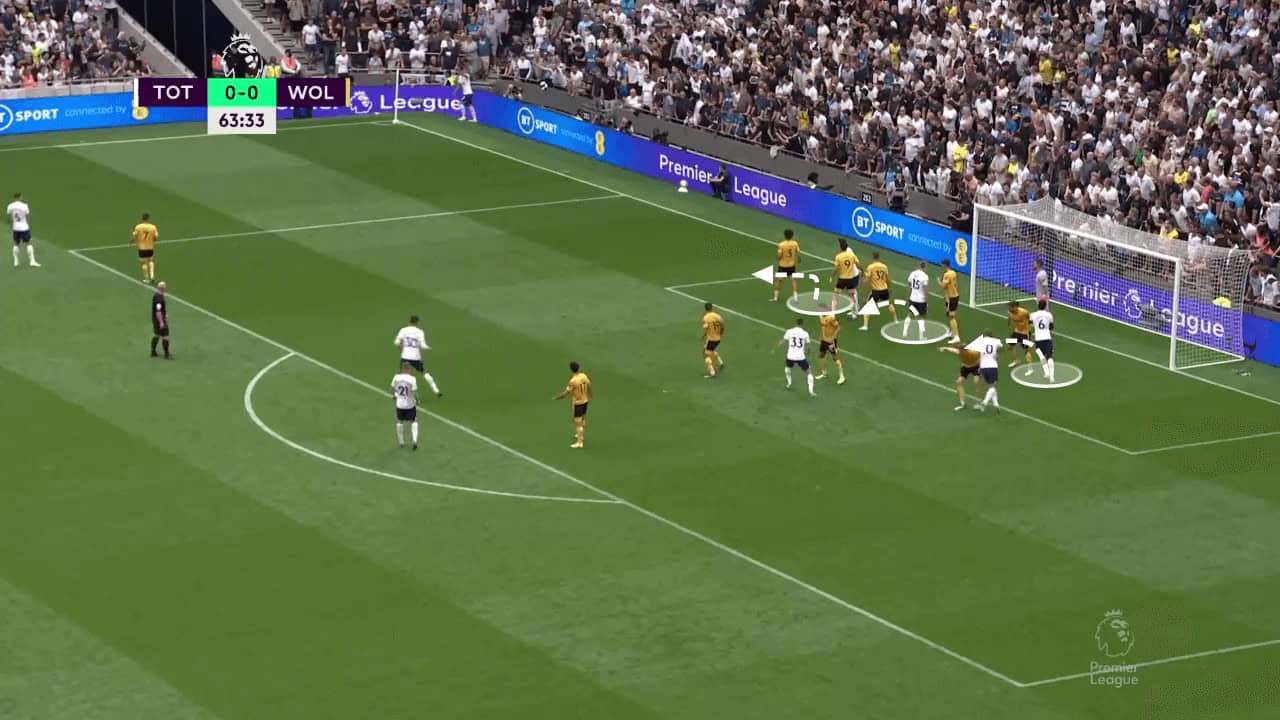
The benefit of making a run from the blindside of a defender is that they cannot see and track an attacker’s movement, until after they step in front of them. By the time the attacker moves into the defender’s line of sight, their momentum allows them to create separation from a defender, making an effort on goal a viable option. The defender doesn’t have time to follow the attacker, and so the attacker has time to redirect the header goal-wards as long as the delivery is accurate. With the quality of the likes of Heung-Min Son and Ivan Perisic, these corners are regularly delivered to the target areas with precision and pace.
Furthermore, when an attacker steps up the queue away from one defender and onto the next, the original defender falls into a false sense of security as they assume there is no attacker around them. The defenders let their guard down as an attacker moves away before a new attacker comes into that space from a different angle.

Tottenham Hotspur lay their eggs in different baskets during near-post routines. As the space to cross the ball into is limited, there are often times when a cross may not be accurate, even if off by a few yards. In order to increase their chances of making the first contact in these instances, the Spurs players attack different areas around the front of the six-yard box to ensure that the ball goes towards a white shirt every time.
In the instance below, both Eric Dier and Ben Davies start around the goalkeeper. When players start within the goalkeeper’s proximity, they are often left unmarked due to the fact the keeper will be able to claim the ball should it go directly towards them. These players can then make runs to their designated spots without a defender tracking their runs.
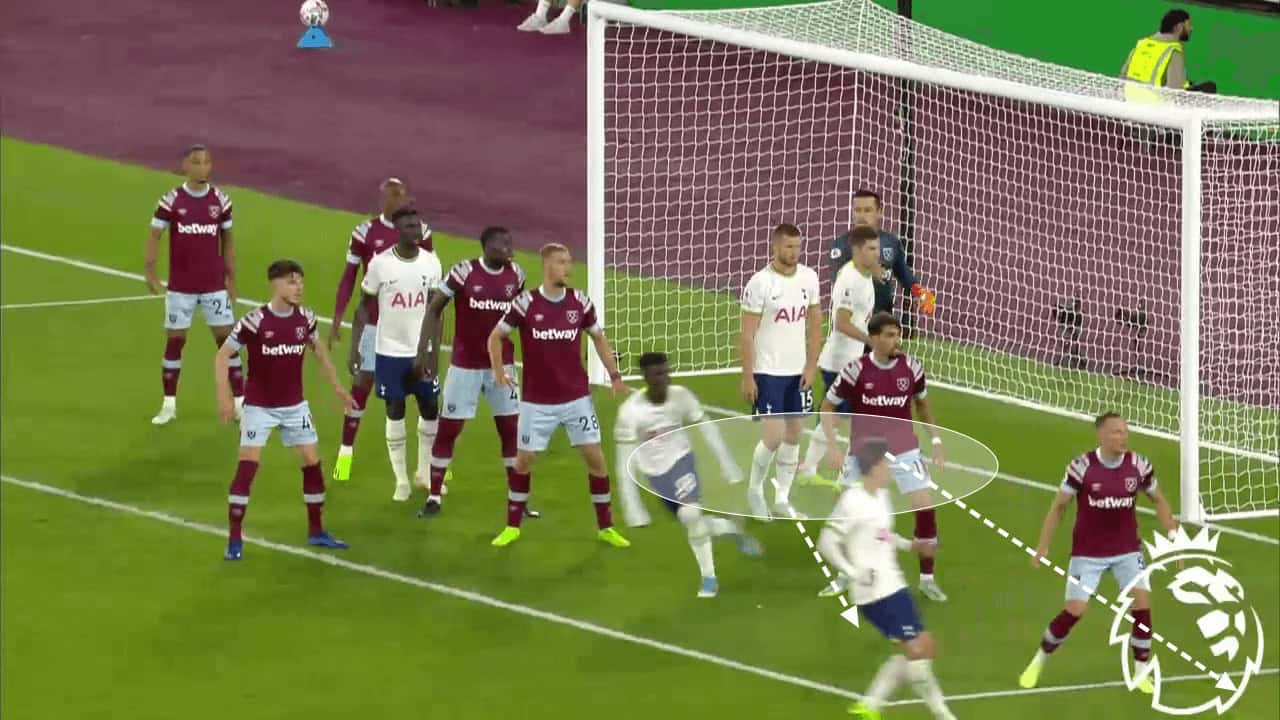
Two different potential areas around the front edge of the six-yard box are covered should the ball land in any of the potential areas highlighted below. Usually, Spurs have a larger number of players inside the box, but with a winning score line, the need for a goal was lesser, thus being more conservative from the corner.
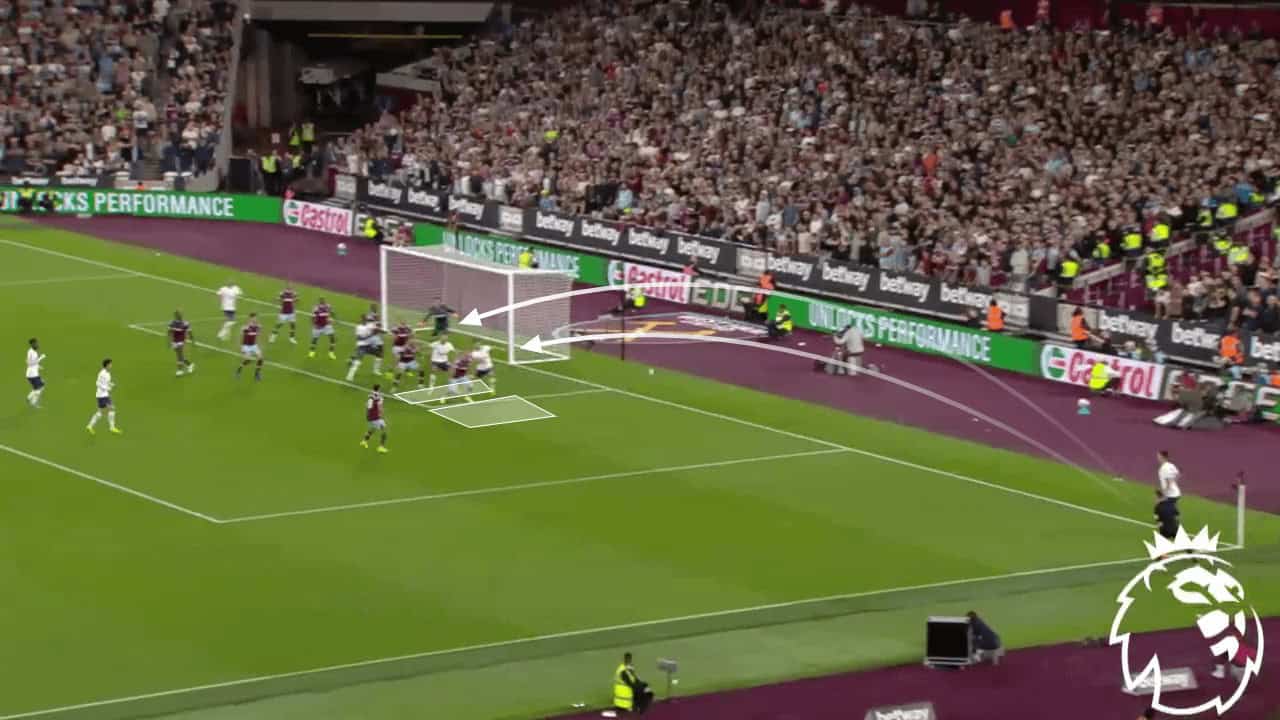
Creating space at the near post
On certain occasions, rather than gambling across different areas of the near post, Spurs have attempted to create space in a specific zone for one player. While the need for the cross becomes greater due to fewer attacking options, the potential reward also greatly increases, with the target player often having an unopposed header on goal from within six yards out should the routine work out as planned.
Tottenham have utilised screens in order to create this space inside the six-yard box. In the clip below, we can see Liverpool‘s Konate highlighted. He is being screened, which prevents him from being able to contest for the ball, which then leaves the black zone open, available for a Spurs player to get into and attempt a header on goal with no interruptions. Thiago, who is just above Konate, is also screened to make sure that space around the six-yard box remains open, while Fabinho is dragged out of the danger zone through a decoy run.

All these little moves add up to create a lot of space inside the six-yard box. All that’s required is for Lenglet to dismark himself in order to be able to head the ball. The image below helps us see Lenglet use a smart body feint to unbalance Henderson, thus allowing him the separation necessary to be able to attack the ball unopposed. With man-marking approaches like the one below, it is vital that players can create separation, whether that is through individual moves or team shapes.
Without the sharp change of direction, the move amounts to nothing, highlighting just how important it is for players to create a yard of space from which they can jump for the ball whilst staying balanced.
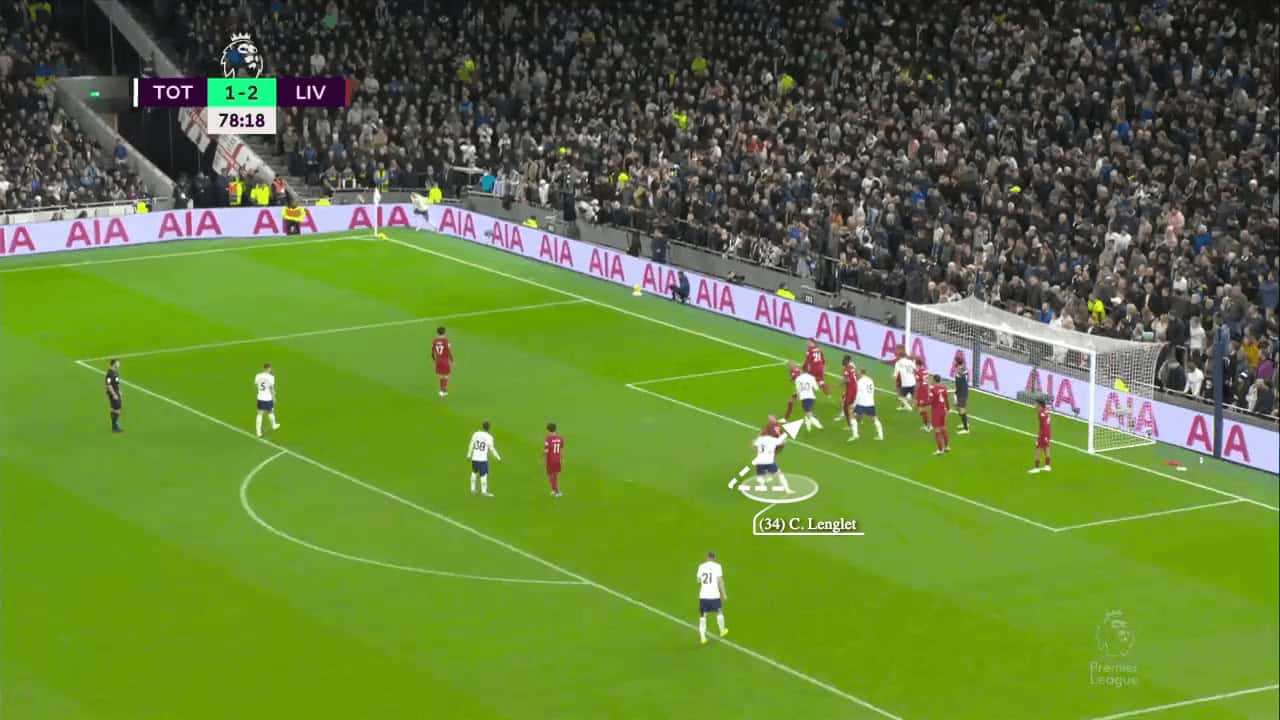
Attacking space at the near post
There have been occasions when Spurs had been afforded extra space around the front of the six-yard box, usually when the players started their runs from more central areas. As most teams prefer to mix man marking and zonal defending, it becomes possible for man markers to be manipulated through the movements of attackers. Conte’s Spurs use this key detail to drag as many defenders as possible away from the front edge of the six-yard box.
They utilise late runs into the bigger spaces to maximise the probability of getting the first contact on the header. They do not intend for these headers to go directly into the goal, rather they want to flick the ball towards the far post for a second-phase finish. As the flick doesn’t have to be powerful or too accurate, the run doesn’t have to allow the attackers to be balanced. This means Spurs players can make runs towards the ball from less favourable positions where they are less likely to be tracked as the flick that’s aimed for can be minimal and does not have to be accurate. As a result, Spurs have consistently had players make attacking runs from behind the goalkeeper, where it becomes hard to track attackers’ movements.
In the picture below, Romero runs around the goalkeeper, using him to give himself separation from the defender. The defender then also can’t see Romero’s run as he is focused on the ball, meaning that Romero can sprint early and use the momentum to ensure the defender can’t catch him. This ensures that Romero gets to the designated area first, from where he can flick the ball to the back post where we can expect to find a prolific Harry Kane lurking.
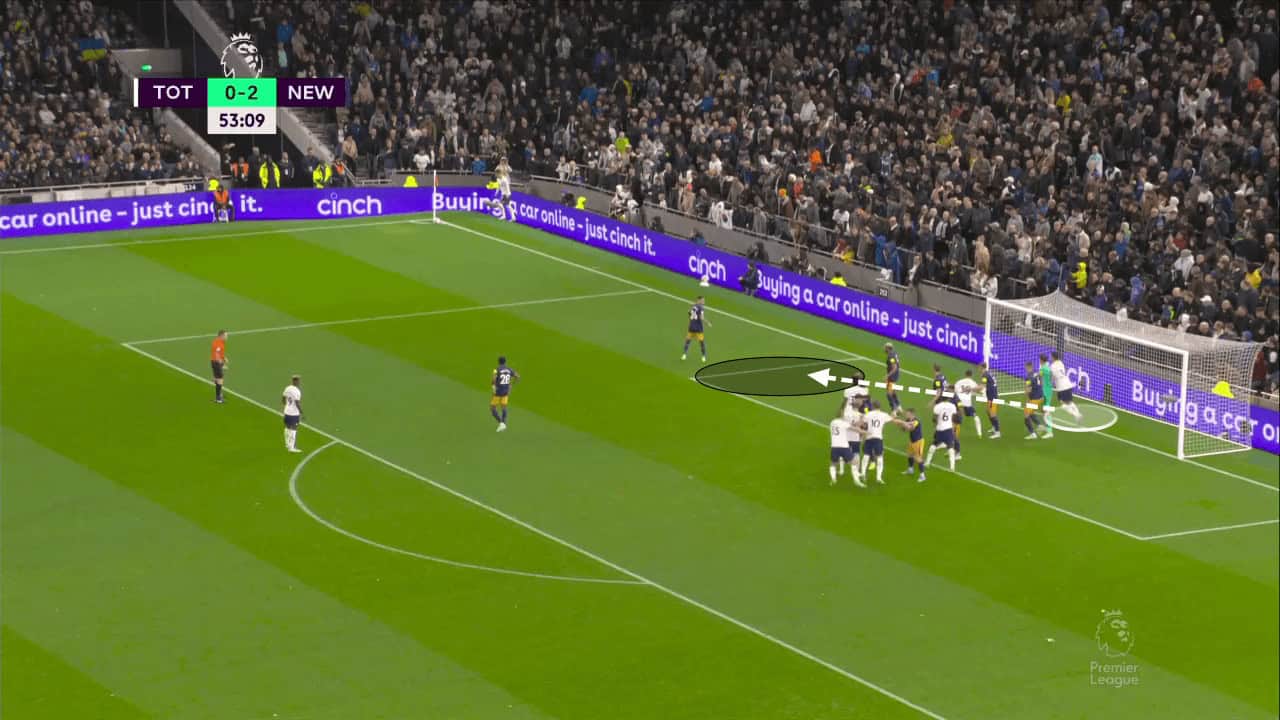
One final way in which Spurs have exposed defences with a lack of zonal marking is through the use of ‘anchoring’. We have in previous articles discussed this term which is similar to a screen, but with the key difference that the player anchoring has his eyes on the ball, with the possibility of attempting to go for the ball by creating space for himself.
In the example below, Eric Dier anchors to create space in front of himself, so that even if no one makes the run, he will still be able to affect the play. However, in this scenario, Ben Davies is able to get separation through the timing of his run, which allows him to arrive in the black area before his marker can. As a result, he is able to make a headed effort towards the back post with no competition for the ball.
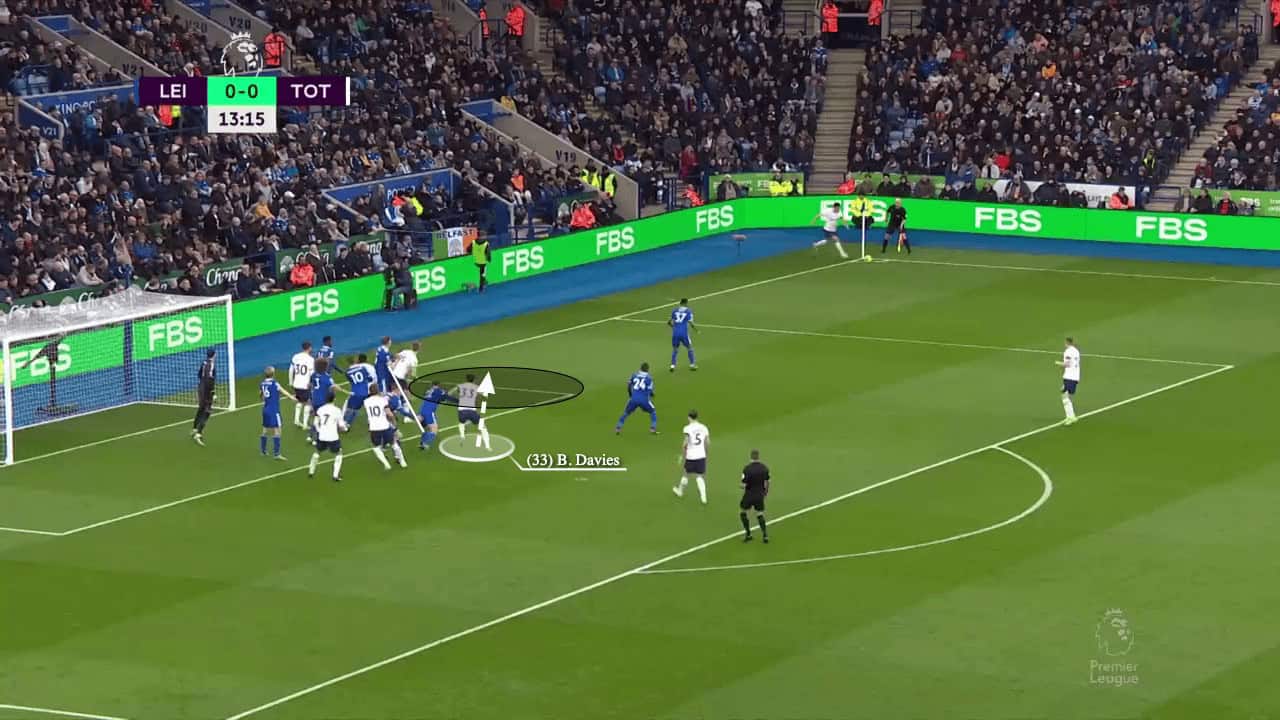
Harry Kane’s Excellence
A key component of every single one of the previous examples is for a deadly poacher to have the positional intelligence and instincts to arrive at the back post every time whilst still being able to react to play. Antonio Conte has previously used a similar routine at Chelsea, with Diego Costa playing an identical role to that of Harry Kane.
Harry Kane has also had an important part to play in every corner, with the task of having to create separation from the defender to get to the ball. The need to create separation was lesser, due to the fact that his job is usually to tap the ball in from within six yards. With a simpler finish required, Kane didn’t always need to be balanced to redirect the ball. However, there are times when the flick on towards the back post may be less accurate than expected and Kane requires the separation to be able to react and attack the ball wherever it lands around the back of the six-yard box.
In the example below, Kane used a drop of the shoulder to lure Nathan Collins away from the goal before quickly attacking the ball. The ball drops slightly shorter than expected and so that yard of space was crucial for Kane to be able to attack the ball before any Wolves player was able to do so.

In a more recent example, Harry Kane has displayed his intelligence and box instincts by rotating his body as the ball redirects, allowing him to place the ball into the back of the net. If Kane was strictly facing the goal, he wouldn’t have had the opportunity to turn towards the ball. Staying perpendicular to the goal allows Kane to be able to cover the entire width of the six-yard box, increasing his chances of getting to the second ball.
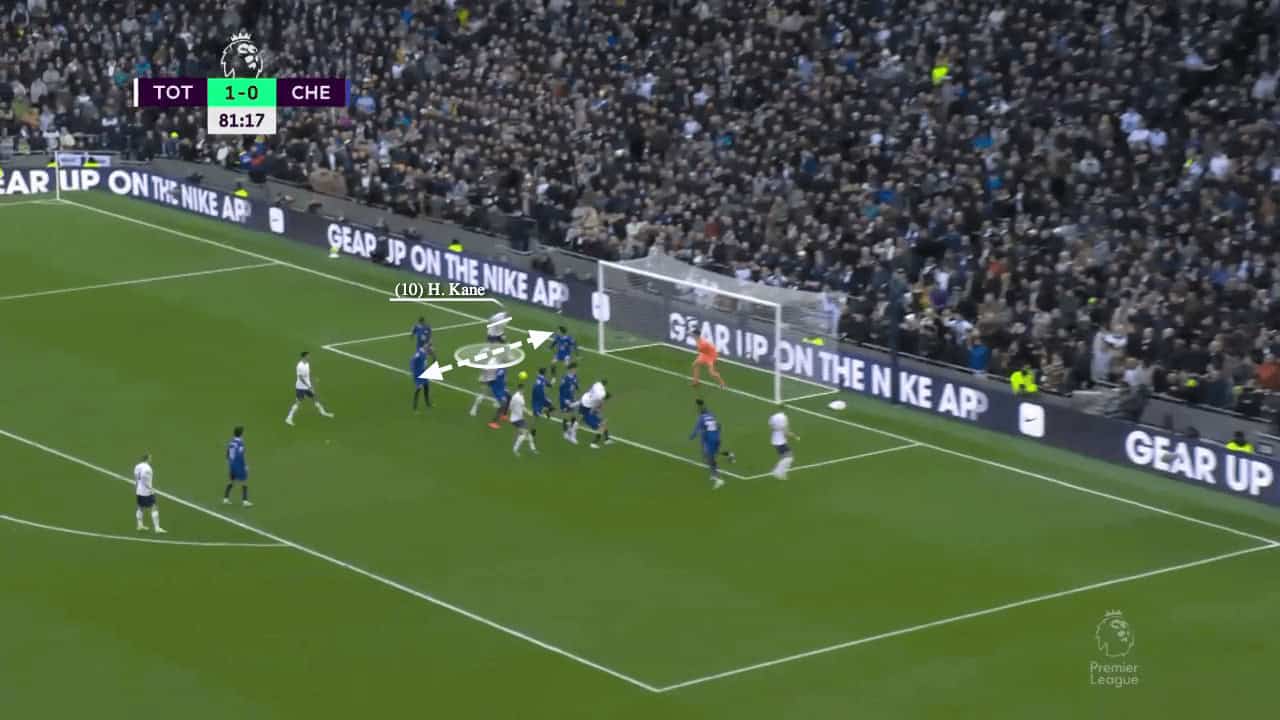
Summary
This tactical analysis shows just how much detail goes into one style of corner-taking. Antonio Conte’s backroom staff have spent a lot of time making detailed plans for all components of the game, with it being clear how well-organised his team is by being able to follow all the instructions even in Conte’s absence. This particular corner routine has allowed Spurs to climb up the table, picking up points even when performances aren’t as good as they should be.






Comments